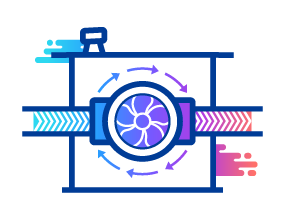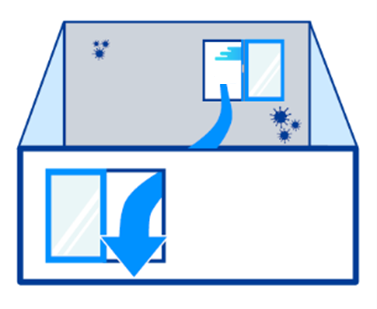Having good ventilation and air filtration is important. Bringing in outside air (ventilation) and having efficient filters to clean the air, improves indoor air quality. This helps reduce the transmission of respiratory infections. Use the tips below to improve your indoor air quality (IAQ). This can limit the exposure to harmful chemicals and wildfire smoke (PDF).
To prevent the spread of respiratory infections, CDPH recommends providing a minimum of at least 5 air changes per hour or 30 cfm/occupant (cubic feet per minute per occupant) of equivalent clean airflow, whichever is greater. Achieve this goal through a combination of ventilation with outdoor air. And filtration using heating, ventilation, and air-conditioning (HVAC) filters and/or portable air cleaners. For more information on calculating equivalent clean airflow, see the California Department of Public Health (CDPH) Guidance for Ventilation.
Follow the steps below to reach these recommendations and improve IAQ.
Optimize Your Mechanical Ventilation (or HVAC) System
 If your space has an HVAC system, ensure it is providing required outdoor air ventilation rates. See rates in the California building code (Title 24). Keep the HVAC system running during space occupation and when practical. First it brings fresh outside air in. Then, it circulates air through filters to remove harmful particles. Be sure to install high quality air filters in your system. Set the fan on the system’s thermostat to the “ON” position instead of “AUTO.” This will cause the system’s fan to continue bringing in outside air. Your HVAC system serves two purposes. MERV 13 or greater are best if your system has the capacity. Be sure to perform all routine maintenance on your ventilation system and replace air filters when recommended. For employers, involve maintenance staff and ventilation professionals to assist with these updates.
If your space has an HVAC system, ensure it is providing required outdoor air ventilation rates. See rates in the California building code (Title 24). Keep the HVAC system running during space occupation and when practical. First it brings fresh outside air in. Then, it circulates air through filters to remove harmful particles. Be sure to install high quality air filters in your system. Set the fan on the system’s thermostat to the “ON” position instead of “AUTO.” This will cause the system’s fan to continue bringing in outside air. Your HVAC system serves two purposes. MERV 13 or greater are best if your system has the capacity. Be sure to perform all routine maintenance on your ventilation system and replace air filters when recommended. For employers, involve maintenance staff and ventilation professionals to assist with these updates.
Open Doors and Windows (Natural Ventilation)
 Open windows and hallways doors to receive natural ventilation. This is only when outdoor air quality is safe. Use fans to increase the effectiveness of open windows and doors. Fans draw in fresh air from the outside and promote gentle cross-ventilation. Ceiling fans improve air mixing which helps reduce respiratory infection spread as well.
Open windows and hallways doors to receive natural ventilation. This is only when outdoor air quality is safe. Use fans to increase the effectiveness of open windows and doors. Fans draw in fresh air from the outside and promote gentle cross-ventilation. Ceiling fans improve air mixing which helps reduce respiratory infection spread as well.
Use Portable Air Cleaning Devices
 Use portable air cleaning devices (PACs) to improve IAQ. Use devices that circulate air through high quality HEPA filters. HEPA filters remove infectious particles by filtering them out of the air. Avoid devices that advertise ionizer, ozone, or other cleaning methods. These can add chemicals to the air. Choose a device that is appropriately-sized for your space (1). Additionally, a low-cost DIY PAC can be a temporary option but not for permanent use. You can use many devices if your space is large or if using one larger PAC is too loud. Place your PAC toward the center of your space where it does not pose a tripping hazard. Avoid placing devices in unused corners of rooms or beneath tables. They cannot clean the air as well when in these locations.
Use portable air cleaning devices (PACs) to improve IAQ. Use devices that circulate air through high quality HEPA filters. HEPA filters remove infectious particles by filtering them out of the air. Avoid devices that advertise ionizer, ozone, or other cleaning methods. These can add chemicals to the air. Choose a device that is appropriately-sized for your space (1). Additionally, a low-cost DIY PAC can be a temporary option but not for permanent use. You can use many devices if your space is large or if using one larger PAC is too loud. Place your PAC toward the center of your space where it does not pose a tripping hazard. Avoid placing devices in unused corners of rooms or beneath tables. They cannot clean the air as well when in these locations.
Reference
Follow the Clean Air Delivery Rate (CADR) “2/3” rule: PACs should have a CADR at least 2/3 of the room’s floor area.